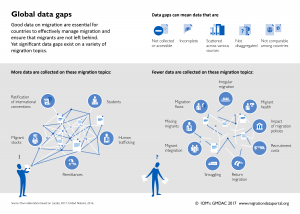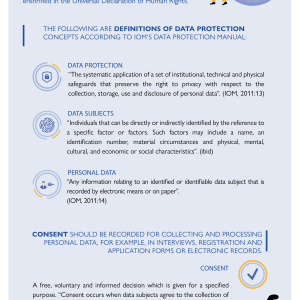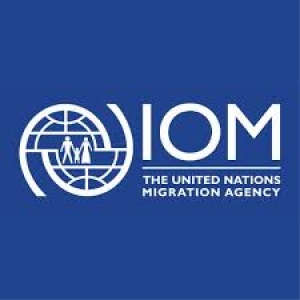If every era poses its dilemmas, then our current decade will surely be defined by questions over the challenges and opportunities of a surge in migration. The issues in addressing migration safely, humanely, and for the benefit of communities of origin and destination are varied and complex, and today’s public policy practices and tools are not adequate. Increasingly, it is clear, we need not only new solutions but also new, more agile, methods for arriving at solutions.
Data are central to meeting these challenges and to enabling public policy innovation in a variety of ways. Yet, for all of data’s potential to address public challenges, the truth remains that most data generated today are in fact collected by the private sector. These data contains tremendous possible insights and avenues for innovation in how we solve public problems. But because of access restrictions, privacy concerns and often limited data science capacity, their vast potential often goes untapped.
Data Collaboratives offer a way around this limitation.
Data Collaboratives: A new form of Public-Private Partnership for a Data Age
Data Collaboratives are an emerging form of partnership, typically between the private and public sectors, but often also involving civil society groups and the education sector. Now in use across various countries and sectors, from health to agriculture to economic development, they allow for the opening and sharing of information held in the private sector, in the process freeing data silos up to serve public ends.
Although still fledgling, we have begun to see instances of Data Collaboratives implemented toward solving specific challenges within the broad and complex refugee and migrant space. As the examples we describe below suggest (which we examine in more detail Stanford Social Innovation Review), the use of such Collaboratives is geographically dispersed and diffuse; there is an urgent need to pull together a cohesive body of knowledge to more systematically analyze what works, and what doesn’t.
This is something we have started to do at the GovLab. We have analyzed a wide variety of Data Collaborative efforts, across geographies and sectors, with a goal of understanding when and how they are most effective.
The benefits of Data Collaboratives in the migration field
As part of our research, we have identified four main value propositions for the use of Data Collaboratives in addressing different elements of the multi-faceted migration issue. These include:
- Improved situational analysis. Understanding migrant and refugee flows is one of the key challenges confronting governments and the aid industry in their efforts to effectively manage migration, and alleviate the hardship of refugees and other migrants in vulnerable situations. We now know that various forms of information (including real-time satellite data and social media feeds) can play an important role in this regard. For example, DigitalGlobe, a satellite imagery company, has been working with UNHCR to provide data on Sudanese refugees. Likewise, the GovLab is working with UNICEF and the Harvard Humanitarian Initiative to leverage satellite data towards similar goals in Somalia. In both these cases, data are allowing stakeholders to better visualize, and thus respond more effectively, to migrant flows.
- Better understanding of the migration drivers. What drives migrant and refugee flows? How and when do populations move across borders or within countries? Various forms of data, including social media data and search query data, can also help surface answers to these questions. For example, approaches such as the Data Challenge on Integration of Migrants in Cities, have been used in the EU to better understand migrant behavior in cities across eight countries.
- Enhanced prediction and forecasting. The ability to predict migrant flows could allow for more systematized, effective and humane responses by nation states and aid groups. Various studies and real-world projects have shown that data can play a key role in this regard. For example, a June 2017 Pew Research Center study indicated that certain search terms (e.g., Arabic-language searches in Turkey that included the word “Greece”) could help forecast migrant flows into Europe. Various other studies, such as this report on human mobility on malaria-endemic countries have similarly mined census information and other government data to predict refugee and migrant flows.
- More effective impact assessments. Impact assessment is an often under-appreciated part of any effort to address migrant flows. But understanding what works, and under what conditions, is critical to addressing large movements of migrants and refugees and better manage migration now and in the future. This is fundamentally an information challenge: gathering data on current or previous interventions and assessing their strengths and shortcomings. Such efforts are now underway in Europe (for example, as part of the SoBigData Exploratory migration studies project).
The challenges and potential of Data Collaboratives in the migration field
The use of Data Collaboratives (and, more generally, private data) in the migration space remains somewhat ad hoc and nascent. While the above four value propositions are beginning to be clear, we still need to do a lot of work to really understand the potential of data for addressing specific types of problems in the migration universe. It is also important to acknowledge some of the very real challenges.
For example, the information basis is often poor – data may be limited or of poor quality, especially in settings characterized by conflict or humanitarian crisis. In addition, and as always with data-sharing initiatives, especially when vulnerable populations are represented in the data, there are very real privacy concerns to take into account. The need for data responsibility in the field is increasingly recognized and studied, as evidenced by the diversity of perspectives in our Selected Readings on Data Responsibility, Refugees, and Migration.
Finally, establishing Data Collaboratives require significant and time-consuming efforts from both data holders on the supply side, and institutions that represent the demand. To find new ways to lower these high transaction costs and to amplify the positive impact of cross-sector data sharing for the public good, the GovLab is advancing the concept of Data Stewardship to promote responsible data leadership in more sustainable, systematic and responsible ways.
These challenges are not grounds for ignoring the potential. Our research—and the above examples—clearly illustrate the possibilities and scope of using Data Collaboratives in the migration space. At the GovLab, we are in the process of continuously gathering related information, data and case studies to complement and enrich our existing research base. We would welcome your inputs to help build our body of knowledge. This could also contribute to the work of the Big Data for Migration Alliance (BD4M), soon to be launched by IOM’s Global Migration Data Analysis Centre (GMDAC) and the European Commission Knowledge Centre on Migration and Demography (KCMD).
The authors would like to thank Michele Vespe and Marzia Rango for sharing their insight and review. Both were also the driving force behind a conference on Big Data and Alternative Data Sources on Migration that took place in November 2017, and was co-organized by the European Commission’s Knowledge Centre on Migration and Demography (KCMD) and the IOM's Global Migration Data Analysis Centre (GMDAC). Many of the insights and examples listed in our SSIR paper emerged during that conference.









